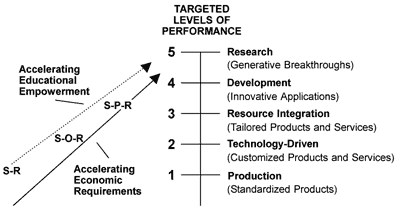Crossing Curves:
5. Converging Curves
In Figure 6, we see the converging curves of functional policy. As may be viewed, both the educational empowerment curve and the economic requirements curve converge upon the higher level targeted performance. What this means is that the citizen-workers are empowered by processing systems to perform all the way up to and including research and development.

Figure 6. Converging Curves of Functional Policy
“No Child Left Behind†legislation simply does not empower the learners and future workers to acquire, apply and transfer S–P–R Generative Processing Systems. Indeed, NCLB regresses from the threshold of S–O–R Discriminative Learning to S–R Conditioned Responding. It is a product of an ignorant administration that is neither cognizant of the elevated requirements its trade policy is imposing nor capable of converging and integrating economic and educational policies.
In this context, the psychology of processing has come to a critical crossroad. Major theoretical changes have not occurred in more than five decades. The philosophical bases for most current theories have existed since the advent of the Industrial Revolution two centuries ago. But, the world has changed dramatically. The rapid flow of information makes human processing a vital topic of survival and growth. Now the Age of Ideation presents the choice squarely before us: facilitate generative human processing or face extinction in a constantly changing world to which we could not adapt.
Conditioning represents reactive responses to specific environmental stimuli. This stimulus-bound view of humanity relies on the conditioning history of the responder. It assumes an unchanging world, where human development occurs as a monotonic increase in associational complexity.
Learning represents active, expanding responses to variations in the environment. It relies on the individual’s opportunity to share or acquire new responses. It assumes a slowly changing world with behavioral options as the products of an internal cognitive structure.
Thinking represents proactive initiatives used to transform the environment. It relies on an individual’s ability to analyze, synthesize and project the probabilities of any future actions, and then to operationalize the goals and technologize the programs of the preferred actions. It assumes a constantly changing world where all processors are independently and interdependently defined.
As a rule, the unknown is inherently aversive to conditioned responders. They cannot probe what they cannot respond to.
The unknown is existentially acceptable to participative learners. They have been reinforced for transforming it into known, manageable dimensions.
The unknown is attractive to processors. Their mission is to generate the known by projecting the future. They believe that where the brain can project, the body can follow.

December 14th, 2007 at 6:56 pm
Dear Bob,
As I understand it, the most effective way to close the gap between increasing requirements and decreasing performance is to equip people with a repertoire of processing skills. Unfortunately, the emphasis in education and in corporation is on standard procedures and best practices instead of multi-dimensional processing constructs. Learning procedures is simply a form of conditioned responding. Benchmarking best practices taps the advantages of discriminative learning. Neither of these approaches will close the gaps we need to close. Multi-dimensional processing constructs will help us think our way out of the problems we are facing.